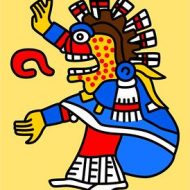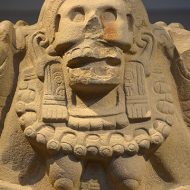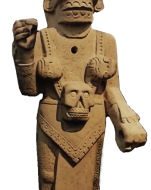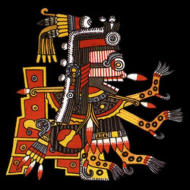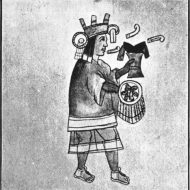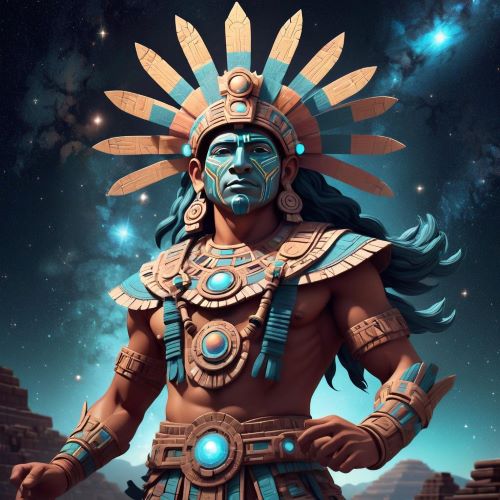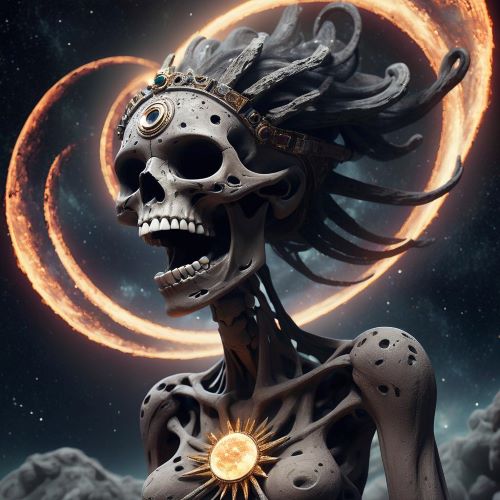Citlalicue : Goddess of the Stars
Listen
At a glance
| Description | |
|---|---|
| Origin | Aztec Mythology |
| Classification | Gods |
| Family Members | Citlalatonac (Husband) |
| Region | Mexico |
| Associated With | Milky Way, Stars |
Citlalicue
Introduction
Citlalicue, also known as Citlālinicue and Ilamātēcuhtli, holds a revered position in Aztec mythology, earning her the title of the “star garment.” Within the intricate tapestry of Aztec cosmology, she plays significant roles as a creator goddess, credited with shaping the cosmos. Her influence extends to the creation of stars, the Milky Way, Earth, as well as the fundamental concepts of death and darkness.
This celestial deity, adorned in a skirt adorned with twinkling stars, embodies the essence of creation, darkness, and the celestial realm. Her name, translating to “Star Garment” or “Lady of the Luminous Starry Skirt,” encapsulates the breathtaking expanse of the night sky. Through this evocative title, Citlalicue becomes a symbol of both cosmic beauty and earthly fertility, seamlessly weaving together imagery that transcends the realms of mythology and reality.
Physical Traits
Citlalicue is commonly portrayed as an elegant figure, her deep complexion embellished with celestial accessories. Her skirt, a manifestation of her essence, sparkles with the radiance of innumerable stars, inviting contemplation of the boundless and enigmatic cosmos. Atop her head rests a feathered headdress, reminiscent of the celestial birds believed to dwell within the Milky Way. Whether she cradles a shield adorned with stars, signifying her protective instincts, or a spindle and cotton bolls, emblematic of her ties to life, death, and the cyclical rhythm of existence, Citlalicue’s depictions share certain recurring elements.
Though artistic representations of Citlalicue may vary, certain consistent features create a vivid and recognizable image. Her dusky skin, at times embellished with celestial tattoos, serves as a visual link to the nocturnal sky and the underworld. Her eyes, often portrayed as starry orbs themselves, convey the wisdom of eons and the enigmas of the cosmos. Occasionally, her lips bear the suggestion of bloodstains, alluding to her role in the perpetual cycle of life and death. In certain depictions, she appears with a pregnant form, underscoring her connection to creation and fertility.
Family
Citlalicue’s association with her husband, Citlalatonac, adds a layer of complexity to her divine narrative. Together, they are occasionally intertwined with the Aztec mythology’s inaugural human pair, Nata and Nena. The collaborative efforts of Citlalicue and Citlalatonac are believed to have forged the celestial masterpiece of the night sky, adorning it with innumerable stars that served as guiding beacons for the Aztec people.
The intricacies of Citlalicue’s familial connections rival the enchantment of her own divine essence. Predominantly coupled with Citlalatonac, often referred to as the “Star Lord,” they share credit for the creation of stars, the Milky Way, and even the Earth itself. Some narratives draw a parallel between them and the first human couple, Nata and Nena, suggesting a pivotal role as progenitors of humanity. In the pantheon of Aztec deities, Citlalicue assumes a noteworthy position. At times, she is identified with Ilamatecuhtli, also known as the “Old Woman of the Earth,” a goddess intricately tied to childbirth, death, and the underworld. This association sheds light on Citlalicue’s dual nature, embracing both the vibrant forces of creation and the solemn realms of darkness.
Other names
In addition to being known as Citlalicue, this divine figure is recognized by alternate names such as Citlālinicue and Ilamātēcuhtli. These alternative names serve to accentuate her sacred connection to celestial bodies and the act of creation. The diverse aspects and roles attributed to her find expression in the various titles she bears. Cihuacoatl, translating to “Serpent Woman,” underscores her affiliation with the earth and the intricate cycles of life and death. Tonacacíhuatl, meaning “Our Mother of Flesh,” highlights her pivotal role as a nurturing and life-bestowing force. Xocotlicue, or “Flower Skull,” unveils her dual association with both beauty and mortality.
Powers and Abilities
Citlalicue’s powers and abilities find their roots in the realms of creation and celestial phenomena. Revered as the goddess of both creation and stars, she possesses the extraordinary ability to usher in new celestial bodies. This divine association places her at the forefront of Aztec mythology, underscoring her pivotal role in their belief system. Moreover, Citlalicue is also acknowledged as the goddess presiding over death and darkness. As a celestial deity, her powers span as expansively as the vast night sky itself. She orchestrates the movement of stars, influences the intricate cycles of the universe, and commands the forces of darkness. Her ties to the underworld confer upon her the dominion over both death and rebirth, establishing her as a mediator between the realms of the living and the deceased. The fusion of her connections to fire and the celestial sphere endows her with profound power and wisdom.
Modern Day Influence
Citlalicue’s impact transcends the confines of ancient Aztec mythology, reaching into the contemporary sphere where her narrative continues to enthrall modern audiences. Through her story, we gain valuable glimpses into the intricacies of Aztec cosmology and belief systems. Beyond merely being a goddess of the stars, Citlalicue emerges as a symbol embodying duality, encapsulating themes of creation and destruction, as well as the cycles of life and death. Her mysterious presence serves as a poignant reminder of the interconnectedness woven into the fabric of the universe, emphasizing the vastness of the unknown and the perpetual cyclical nature of existence.
Related Images
Frequently Asked Questions
What is lorem Ipsum?
I am text block. Click edit button to change this text. Lorem ipsum dolor sit amet, consectetur adipiscing elit. Ut elit tellus, luctus nec ullamcorper mattis, pulvinar dapibus leo.
What is lorem Ipsum?
I am text block. Click edit button to change this text. Lorem ipsum dolor sit amet, consectetur adipiscing elit. Ut elit tellus, luctus nec ullamcorper mattis, pulvinar dapibus leo.
What is lorem Ipsum?
I am text block. Click edit button to change this text. Lorem ipsum dolor sit amet, consectetur adipiscing elit. Ut elit tellus, luctus nec ullamcorper mattis, pulvinar dapibus leo.
What is lorem Ipsum?
I am text block. Click edit button to change this text. Lorem ipsum dolor sit amet, consectetur adipiscing elit. Ut elit tellus, luctus nec ullamcorper mattis, pulvinar dapibus leo.
What is lorem Ipsum?
I am text block. Click edit button to change this text. Lorem ipsum dolor sit amet, consectetur adipiscing elit. Ut elit tellus, luctus nec ullamcorper mattis, pulvinar dapibus leo.

